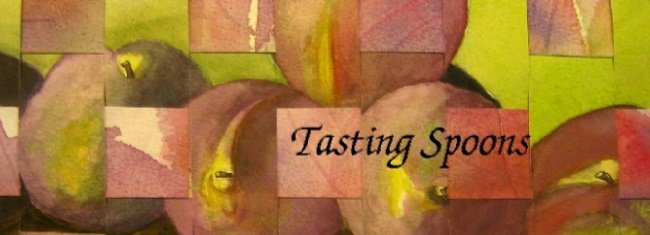Aromatic Braised Lamb with Prunes & Pine Nuts
I don't know about you, but I don't cook lamb all that often. It's expensive, for one thing. And it doesn't appeal to everyone's taste. We've been known to barbecue a butterflied leg of lamb on many a family get-together, but it makes a lot, and I never seem to do well with the leftovers. Cold barbecued lamb just doesn't lend itself very well, to me, to very many recipes. I haven't made that in a long time.
But I was reading Food and Wine the other day and a Catalan lamb stew recipe jumped out at me. You know how that is - it just literally jumped off the page with my scissors and demanded to be made. Whole Foods had some nice boneless shoulder roasts, at $5.99 a pound, so that was an easy decision. It's New Zealand organic lamb, which is even better. Although I do like our Colorado lamb a lot too.
In case you don't know about Catalan cooking - it's an area of Spain that borders on France. And it contains the city of Barcelona (pronounced bar-tha-lona). Much of the area is mountainous. Lots of sheepherders. Therefore, lots of lamb, I'm certain. Lots of fish also since the lower triangle of Catalonia is the coastline containing Barcelona. My DH and I spent 4 days in Barcelona some years ago. All by ourselves. It's a very cosmopolitain city - and European. The restaurants of Catalonia are legend, with many world-reknowned chefs having come from there.
Having grown up in San Diego, right on the Mexican border, I assumed Spanish food was much like Mexican. Altogether wrong I was about that. Spanish cuisine is based a lot on fish, actually, but with fairly simple preparation of things, and not a lot of seasoning.
- The core of Catalan cuisine still comes from the trio of ingredients introduced into the region by the Romans. The trinity of bread, wine and oil has been used ever since in daily life. In Medieval times Arab influences were also to leave their mark on Catalonia and classic Moorish combinations of sweet and sour can still be seen today in favourite dishes such as rabbit with pears and duck with fruit. (from ezinearticles.com)
What's important from this culture to this recipe is the combination of meat and fruit. Very common there. One trip to France introduced me to the affinity of meat and prunes. Prunes are a very common filling for a whole roast chicken. So I was very open to the suggestion of prunes with lamb.
This stew was relatively easy to make - you do have to tediously brown the lamb chunks so they get browned on all sides (I made nearly a double recipe), and not crowded in the pan, either, or they steam rather than brown. But once that was done, it's a very simple amount of preparation (onions, garlic, red wine, carrots, prunes and pine nuts). And a little sprinkling of ground ginger and ground cloves, plus some grated lemon zest.
It was absolutely delicious. I made it a day ahead, separated the meat from the broth to chill it, then was able to remove all the fat before reheating it and adding vegetables (I used carrots and parsnips). Confession time: I forgot to brown the pine nuts, but they added a nice little crunch to the finished dish. I liked the way they looked in the bowl. I added water to the stew when reheating in order to get the vegetables under liquid to finish cooking. The broth was very flavorful (helped, I am sure, by the overnight chilling) and it was nice to thin it a bit. I'll definitely make this again.
Aromatic Braised Lamb with Prunes and Pine Nuts
Recipe: From Spanish Food & Wine (A Crash Course), Food & Wine, Oct. '07
Servings: 4
3 tablespoons extra-virgin olive oil
2 pounds boneless lamb shoulder -- cut into 1 1/2-inch cubes
Recipe: From Spanish Food & Wine (A Crash Course), Food & Wine, Oct. '07
Servings: 4
3 tablespoons extra-virgin olive oil
2 pounds boneless lamb shoulder -- cut into 1 1/2-inch cubes
Salt and freshly ground pepper
3 garlic cloves -- minced
1 medium onion -- finely chopped
1/2 cup dry red wine
1/2 cup water
3 garlic cloves -- minced
1 medium onion -- finely chopped
1/2 cup dry red wine
1/2 cup water
One 1-inch strip of lemon zest -- minced
1 Pinch ground clove
1 Pinch ground ginger
1 cup pitted prunes
1 cup boiling water
2 medium carrots -- thinly sliced
1 Pinch ground clove
1 Pinch ground ginger
1 cup pitted prunes
1 cup boiling water
2 medium carrots -- thinly sliced
[I added 3 parsnips -- peeled, sliced]
1/4 cup pine nuts
1. In a large saucepan, heat the olive oil. Add half of the lamb, season with salt and pepper and cook over moderately high heat until browned on 2 sides, about 3 minutes per side. Transfer to a plate and repeat with the remaining lamb.
2. Add the garlic and onion to the saucepan and cook over moderately low heat, stirring, until softened, 5 minutes. Stir in the wine, 1/2 cup of water, lemon zest, cloves and ginger. Return the lamb to the saucepan and bring to a boil. Cover and simmer over low heat until very tender, about 1 1/2 hours.
3. Meanwhile, in a heatproof bowl, cover the prunes with the boiling water. Let stand until softened, about 10 minutes. Add the prunes with their cooking liquid and the carrots to the stew. Cover and simmer until the carrots are tender, about 20 minutes.
4. In a medium skillet, cook the pine nuts over moderate heat, shaking the pan a few times, until the nuts are toasted, about 4 minutes. Let cool.
5. Season the stew with salt and pepper and spoon into bowls. Sprinkle with the toasted pine nuts and serve.
1/4 cup pine nuts
1. In a large saucepan, heat the olive oil. Add half of the lamb, season with salt and pepper and cook over moderately high heat until browned on 2 sides, about 3 minutes per side. Transfer to a plate and repeat with the remaining lamb.
2. Add the garlic and onion to the saucepan and cook over moderately low heat, stirring, until softened, 5 minutes. Stir in the wine, 1/2 cup of water, lemon zest, cloves and ginger. Return the lamb to the saucepan and bring to a boil. Cover and simmer over low heat until very tender, about 1 1/2 hours.
3. Meanwhile, in a heatproof bowl, cover the prunes with the boiling water. Let stand until softened, about 10 minutes. Add the prunes with their cooking liquid and the carrots to the stew. Cover and simmer until the carrots are tender, about 20 minutes.
4. In a medium skillet, cook the pine nuts over moderate heat, shaking the pan a few times, until the nuts are toasted, about 4 minutes. Let cool.
5. Season the stew with salt and pepper and spoon into bowls. Sprinkle with the toasted pine nuts and serve.
Per Serving: 189 Calories; 15g Fat (74.2% calories from fat); 3g Protein; 8g Carbohydrate; 2g Dietary Fiber; 0mg Cholesterol; 36mg Sodium. Exchanges: 0 Grain(Starch); 0 Lean Meat; 1 1/2 Vegetable; 2 1/2 Fat.
To print a PDF recipe, click title at top.



1 comment:
Sounds very yummy, I love Pine nuts.
Post a Comment